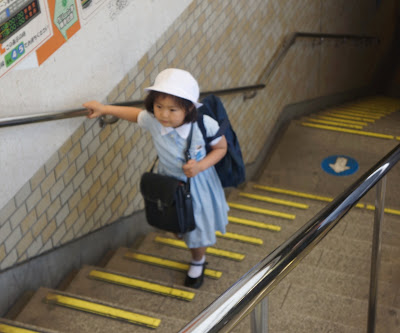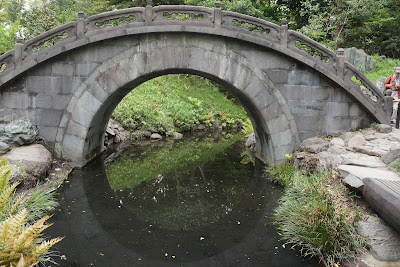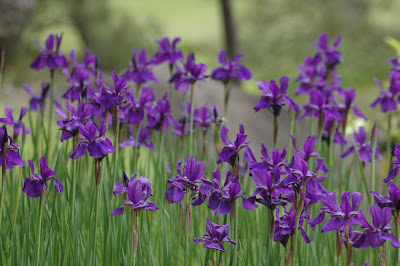They said I can come back to Japan some day. At first I didn't believe them. Then they opened a scrapbook and guess who popped out? My long lost cousins! I had not seen any of them since they came back from Japan three or four years ago.
 |
| Flat Ferdie, Flat Frank, Flat Walter, and ME! |
"We crossed our fingers and said 'Mata ne' (MAH-TAH NAY) instead," Walter piped up. "Mata ne means 'see you later'. We think it sounds happier than sayonara. It worked for us. Maybe it will work for you, too. Now tell us about some of the things you have seen during your visit!"
 |
| I wish I had more time to browse this children's book department |
It was easier than I expected to order food in restaurants. Many restaurants put plastic copies of their food in their front windows.
There are lots of Italian, Indian, Thai, and Korean restaurants. I really liked the French bakery restaurants where I could eat all the rolls I wanted. I liked the Japanese restaurants, too, especially the ramen noodle shops and the sushi restaurants where I could just pick what I wanted from a moving belt on top of the counter.
I was not surprised to see McDonald's restaurants in Japan but I did not expect to see so many Denny's restaurants!
 |
| Have you ever seen such teeny tiny oranges? |
One of my new friends is a retired teacher. She used to teach science to junior high students. Her name is Reiko Ishii but I call her Ishii-san. "-san" means friend in Japanese. I had fun exploring nature with Ishii-san.
 |
| We saw a heron on an island at the Shinto shrine. |
 |
| We saw lots of turtles. They are called "kame" (KAH-MAY). |
 |
| Watch out for that pole! |
Traffic guards make me feel safe when I want to cross a street on foot or in a car. They wear white gloves. This traffic guard is wearing a mask so he will not spread germs when he coughs or sneezes.
Almost everyone in Japan backs their car into parking lot spaces and driveways. This might be a safer way to park. You hardly ever see or hear about car accidents in Japan.
Ryan's friend really likes the man in this picture. He lives in Kamakura, a really neat town where we saw the shrine and the temple on Sunday. This man always helps her back into a parking space. When it is time for her to go home, this man stops the traffic on the busy street so she can leave the parking lot.
Most people in Japan wear hats, especially on sunny days. There are lots of stores here that sell hats. This lady is wearing a hat that protects the skin on the back of her neck as well as on her face. She was also carrying a sunbrella. That's a small umbrella coated with something that keeps out the harmful sun rays.
 |
| She forgot to wear a hat! |
 |
| This little girl will ride a train home from school |
 |
| I climbed a LOT of steps in Japan |
 |
| They are wearing hats |
 |
| Making a new Japanese friend |
Mrs. Matsuzaki is another new friend of mine. She has a daughter who is nine years old. Her daughter rides on a train every day to go to and from a private school in a nearby town.
Mrs. Matsuzaki taught me the proper Japanese way to make a new friend.
First we bowed to each other. That's what we're doing in the picture.
Flat Stanley: Hajimemashite. Flat Stanley desu. Dozo yoroshiku.
Matsuzaki: Hajimemashite. Matsuzaki desu. Dozo yoroshiku.
Flat Stanley: How do you do? My name's Flat Stanley. I'm very glad to meet you.
Matsuzaki: How do you do? My name's Matsuzaki. I'm very glad to meet you.
HAH-JEE-MAY-MAH-SHEE-TAY. Flat Stanley DES. DOH-ZOH YOH-ROH-SHEE-KOO.
This is a good thing to know. I am always happy to make new friends!

I don't feel so sad now that I have looked at these pictures. I am starting to get excited about seeing my teacher and classmates again. I just wish I could ride on a plane instead of in an envelope. Did you know that when you ride on an airplane from Tokyo to Washington, DC, you can arrive in Washington, DC, an hour before you left Japan? That's because Tokyo and Washington, DC, are in different time zones. That's pretty neat and a little bit strange.
Have you been wondering about earthquakes in Japan? I almost forgot to tell you that I felt one when we were in Tokyo. We were in our room on the fourth floor of our hotel when everything started to shake. The couch I was sitting on wiggled and jiggled for about eight seconds. That doesn't seem very long, but try counting to eight very slowly and imagine you are sitting on a couch that is hopping around four stories in the air. Was I scared? Just a little bit. Mostly I was worried about the people who live close to where the earthquakes happen. I am going to pray for them. I hope you will, too.
Mata ne, Japan! See you again (I hope).













































